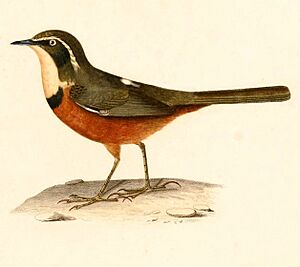Olive-crowned crescentchest facts for kids
Quick facts for kids Olive-crowned crescentchest |
|
|---|---|
 |
|
| Conservation status | |
| Scientific classification | |
| Genus: |
Melanopareia
|
| Species: |
maximiliani
|
 |
|
The olive-crowned crescentchest (scientific name: Melanopareia maximiliani) is a small, colorful bird. It belongs to a special bird family called Melanopareiidae. You can find this bird living in parts of Argentina, Bolivia, and Paraguay.
Contents
Meet the Olive-Crowned Crescentchest
This bird is about 15 centimeters (6 inches) long. That's about the length of a regular pencil! Males usually weigh between 17.1 and 18.0 grams. One female bird weighed 16.7 grams.
What Does It Look Like?
The olive-crowned crescentchest has an olive-brown head and back. Its throat is a deep buff color, which is a yellowish-tan. The chest and belly are a warm, reddish-brown color.
It has a thin, buff-colored stripe above its eye, like an eyebrow. Below this, it has a black "mask" across its face. There's also a black crescent shape and a chestnut-colored band between its throat and chest.
Different Types of Crescentchests
There are three main types, or subspecies, of the olive-crowned crescentchest:
- Melanopareia maximiliani maximiliani
- Melanopareia maximiliani argentina
- Melanopareia maximiliani pallida
The M. m. argentina looks similar to the main type but has lighter colors underneath. The M. m. pallida is even paler. Its throat is more cinnamon-colored, and its face mask is a lighter black. Some scientists think M. m. pallida might even be a separate species because its songs sound different!
Where Do They Live?
The olive-crowned crescentchest lives in different parts of South America.
Their Home Range
- The M. m. maximiliani subspecies lives in the La Paz Department of western Bolivia.
- The M. m. argentina subspecies is found from central Bolivia down to northwestern Argentina.
- The M. m. pallida subspecies lives in southeastern Bolivia, western Paraguay, and northern Argentina.
Preferred Habitat
These birds usually live in dry, scrubby areas. They like places with tall grasses and small bushes. The M. m. pallida subspecies also enjoys living in sawgrass areas in the Chaco Basin.
You can find them mostly at high elevations, from about 1,700 to 2,950 meters (5,600 to 9,700 feet) above sea level. However, in Argentina, they can sometimes be found as low as 1,200 meters (3,900 feet).
How They Live Their Lives
Feeding Habits
The olive-crowned crescentchest usually looks for food alone. Sometimes, you might see them foraging in pairs. They hop through thick plants very close to the ground. Scientists haven't fully recorded what they eat yet.
Reproduction and Nests
In Argentina, these birds lay their eggs from September to December. An active nest was found in central Bolivia in October.
The nests of the M. m. pallida subspecies are shaped like cups. They are made from plant fibers and palm leaves. These nests are well hidden not far above the ground. One nest of the M. m. argentina subspecies was a tunnel lined with grass. Female crescentchests usually lay two or three eggs.
Bird Songs and Calls
The M. m. maximiliani and M. m. argentina subspecies have two main songs. One song sounds like "chuck" notes [1]. The other sounds like "chi" notes [2].
The song of the M. m. pallida subspecies is much faster [3]. The general call of the olive-crowned crescentchest is described as "chit chuck" [4].
Conservation Status
The IUCN (International Union for Conservation of Nature) has listed the olive-crowned crescentchest as a species of "Least Concern." This means that their population is stable, and they are not currently at risk of disappearing. They are quite common in some areas, and in Argentina, they live in several protected natural areas.


